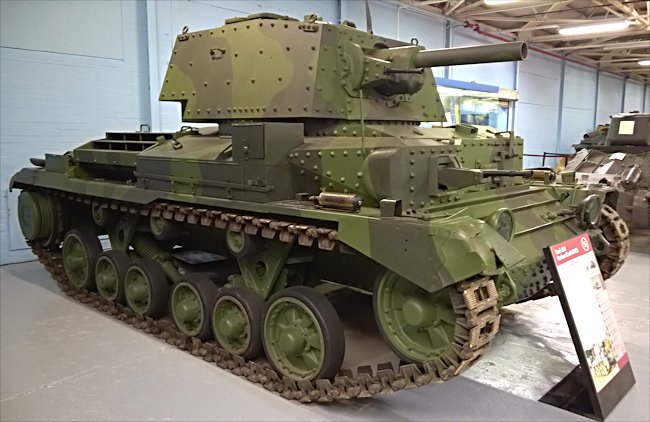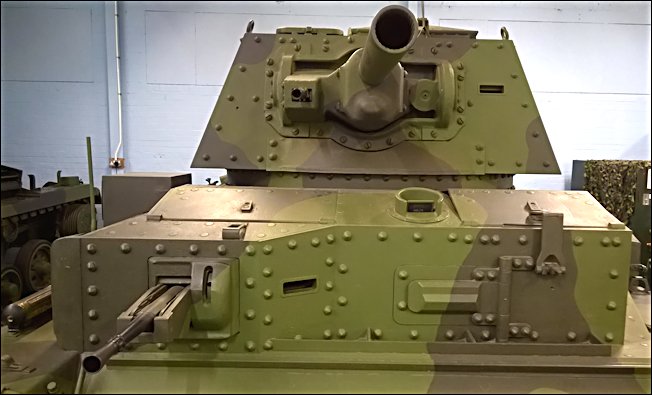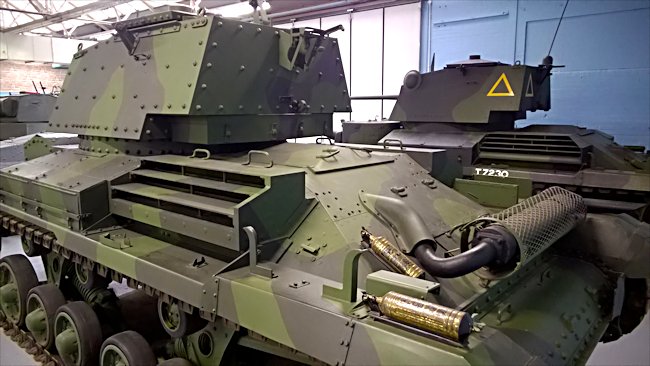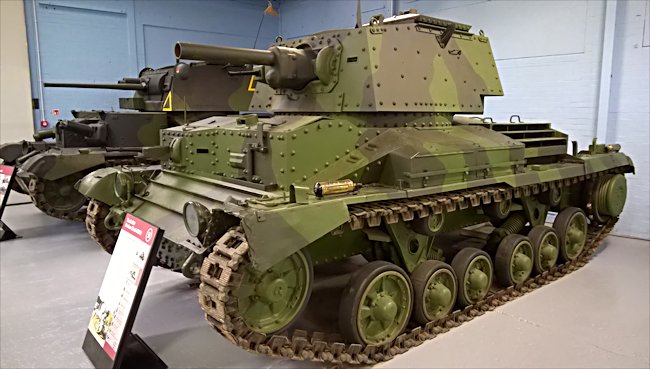A10 Cruiser MkIIA CS tank
This British A10 Mark II Cruiser tank can be seen at the Tank Museum, Bovington, Dorset England. It is one of the few examples of the smoke screen and high explosive HE shell firing support tanks fitted with a 3.7 inch (94mm) howitzer rather than the standard anti tank QF 2pdr gun.

A10 British Cruiser MkIIA CS tank at Bovington Tank Museum from A Squadron, 5th Royal Tank Regiment
When you compare this Cruiser tank with the previous A9 Cruiser MkI tank immediately you notice that the two machine gun turrets at the front of the tank have gone. They made the tank a death trap although the technical term was a 'shell trap'. The driver had a protective armoured box around his head in the A9 and the two small round turrets were either side of it. When a German or Italian shell hit the inside curved side of the turret the shell was deflected in towards the drivers head which nearly always resulted in a fatal injury.
Its armour has been increased from 14mm found on the A9 to 30mm. This added almost 2 tons in weight to the tank. The A10's engine was not upgraded so this extra weight had the effect of reducing the tanks top speed down to 16 mph compared to the A9's top speed of 25 mph.
There is a coaxial BESA Machine Gun to the right of the main gun and one in the hull next to the driver. The A9 had used a Vickers machine gun. It took a crew of 5 to man this tank. It had a top road speed of 16mph (26kph) and off road speed of 8mph (13 kph). This was slow by modern standards but faster than some infantry support tanks. It had a fuel tank that could take 98 gallons (445 Litres) which gave this tank a range of around 100 miles (160km) on the road, less when traveling across country. This example of the A10 tank was produced by railway coach builder Metropolitan-Cammell Ltd who were part owned by Vickers Ltd.

Turret on the A10 British Cruiser MkIIA CS tank
This is a pre World War Two tank. It was developed by Sir John Carden who worked for Vickers in 1934 and entered production in 1938. It was in British army front line service until 1941 when it was replaced by faster and more heavily armoured tanks. The 1st Armoured Division were sent to France in 1939 as part of the British Expeditionary Force (BEF). They were issued with thirty one A10 Mark II tanks to face the might of the massed German Armoured columns. They saw action when the Germans invaded in 1940.
It's 2pdr anti tank gun could knock out any of the German 1940 tanks sent against it but its armour was too thin and its speed too slow. The British did not have enough tanks in France and Belgium to stop the invasion. They were also poorly deployed and supplied. Rather than being kept together as a powerful force they were sent piecemeal to support infantry regiments. All the A10 Cruiser tanks sent across the English Channel never came back to Britain. Most were destroyed by their tank crews to stop them being used by the Germans.
The A10 Cruiser Mark II tank was also sent to North Africa to fight the Italians in the Libyan desert. It performed well against the Italian tanks and the early German Panzer MkIII but the mechanical reliability of its tracks kept letting the the vehicle down. Some took part in the defence of Tobruk in 1941. They were eventually replaced by more modern tanks. The 3rd Royal Tank Regiment did ship with sixty A10 Cruiser Tanks when it was posted to defend Greece.

A10 British Cruiser MkII tank rear view next to a A9 Tank
A lot of pre war tank warfare exercises were done on the barren Salisbury plain in Southern England. There is not a lot of cover and it was found that the use of smoke screens prevented the enemy spotting targets to aim at during an advance or retreat. New specifications were issued by the War office for a variant of the standard Cruiser tank to be built that had a 3.7 inch howitzer that could act as a close support tank. It would be capable of firing high explosive HE shells on infantry, artillery emplacements and soft skinned vehicles as well as laying down smoke screens. This was the tank that was built to those specifications.
This ability to lay down smoke screens was particularly helpful in the deserts of North Africa where there was no natural cover. This is why this tank has the letters CS in its name. CS stands for close support. The letter A in the name means that it is fitted with the later BESA machine guns rather than the original Vickers machine Guns. Examination of the shell storage rack of this A10 Cruiser MarkIIA CS tank reveled that it carried a lot more Smoke shells than HE rounds.

A10 British Cruiser MkIIA CS tank at Bovington Tank Museum next to a A9 Cruiser
The way the A10 tank was named is very confusing because it changed over time. There are three variants: the close support tank as shown on this page and the two other variants that both had the QF 2-pounder (40mm) anti tank gun. The only difference between these two tanks was the type of machine guns they were fitted with: Vickers or BESA.
When the British Army first accepted this tank into operational service it was given the official name of 'Tank, Cruiser, Heavy Mark I'. Then they added A10 to the name to show it was the successor of the A9 tank. Then someone thought that to be completely correct , it should be called the A10 Cruiser MkII tank. It got me very confused when I first came across the different names for the same tank.
Where can I find other preserved A10 Cruiser Tanks?
- The A10 at Bovington Tank Museum is the only surviving example
- Source - Pierre-Oliver Buan - http://the.shadock.free.fr/Surviving_Panzers.html
World War Two books

